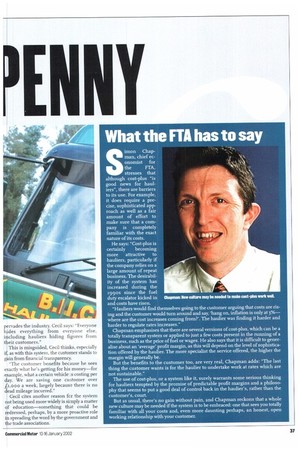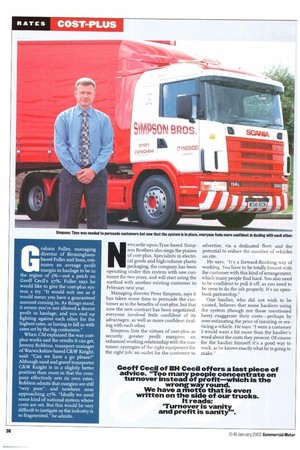PRE Y ?
Page 36

Page 37

Page 38

If you've noticed an error in this article please click here to report it so we can fix it.
Haulage rates often tend to be dictated by the customer, but some hauliers take control of the purse strings. Lucia Cockcroft spoke to two operators recently who invoice their customers with the overheads— and a healthy profit margin to boot.
Everyone knows that the haulage industry is a tough one to make a good living from, with constant pressure on margins and overheads—and that's before you consider factors such as high fuel costs and chronic staffing problems.
On the surface it seems that there is little financial certainty in haulage, and few guarantees that a profit will be made. But dig a bit deeper and perhaps an alternative to this apparent lottery is at hand. It's a system that several hauliers already use successfully, and insist that the difference it makes to their business is huge: 'cost-plus'.
The theory behind cost-plus is amazingly simple. When negotiating rates with the customer, the haulier invoices details of all his company's overheads, and then slaps a profit margin on top of the final figure. The haulier is then assured of a decent profit, and the customer also knows exactly what he is getting for his money. Geoff Cecil, managing director of Gloucester-based BH Cecil, has been using the system successfully since around 1995. The company charges a fixed cost, which includes insurance, driver's wages, the cost of the vehicle and the trailer. Then a running cost is calculated, which includes fuel, wear and tear for tyres, lube oil, an allowance for toll use, and a certain amount for drivers' mobile phone usage.
The sum total of all this is calculated, and a certain amount then added for profit. This varies from customer to customer, and the decision about how much to add as profit margin is largely in the customer's hands. Cecil calculates that his gross profit margin averages around 27%, surely fairly well above the national average for general haulage. He says: "It's very simple. The system. keeps us solvent and allows us to know exactly what our costs and profits are. It means there are no ifs and buts.
"Even if we lost 28 days a year, our vehicles still sit in the yard and earn money."
Cecil obviously has a good head for figures and plenty of old-fashioned common sense, with the emphasis on the phrase 'old-fashioned', as Cecil works entirely without computers, preferring the simplicity of pen and paper.
This isn't rocket science, he says, yet there are a number of reasons why hauliers might fail to take advantage of the cost-plus system, or others like it.
One of them is that a surprising number of hauliers simply don't know their own costs. Another is the culture of secrecy that
pervades the industry. Cecil says: "Everyone hdes everything from everyone else, iiicluding hauliers hiding figures from tlfteir customers."
This is misguided, Cecil thinks, especially as with this system, the customer stands to in from financial transparency.
"The customer benefits because he sees exactly what he's getting for his money—for
Iample, what a certain vehicle :.s costing per ay. We are saving one customer over r,000 a week, largely because there is no cad mileage incurred? Cecil cites another reason for the system at being used more widely is simply a matter f education—something that could be dressed, perhaps, by a more proactive role ' spreading the word by the government and e trade associations. Newcastle-upon-Tyne-based Simpson Brothers also sings the praises of cost-plus. Specialists in electrical goods and high-volume plastic packaging, the company has been operating under this system with one customer for two years, and will start using the method with another existing customer in February next year.
Managing director Peter Simpson, says it has taken some time to persuade the customer as to the benefits of cost-plus, but that now the new contract has been negotiated, everyone involved feels confident of its advantages, as well as more confident dealing with each other.
Simpson lists the virtues of cost-plus as security; greater profit margins; an enhanced working relationship with the customer; synergies of the right equipment for the right job: an outlet for the customer to
advertise, via a dedicated fleet; and the potential to reduce the number of vehicles on site.
He says: "It's a forward-thinking way of working. You have to be totally honest with the customer with this kind of arrangement, which many people find hard. You also need to be confident to pull it off, as you need to be seen to do the Job properly. It's an openbook partnership."
One haulier, who did not wish to be named, believes that some hauliers using the system (though not those mentioned here) exaggerate their costs—perhaps by over-estimating the price of insuring or servicing a vehicle. He says: "I were a customer I would want a bit more than the haulier's word about the costs they present. Of course for the haulier himself it's a good way to work, as he knows exactly what he is going to make."
















































































































































